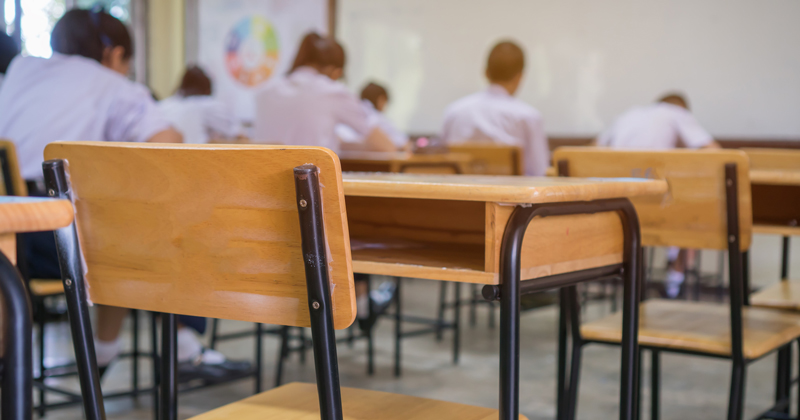Schools should prioritise “encouraging” and “individualised” approaches to tackling absence in addition to “punitive sanctions”, says a new report.
The report by the National Foundation for Educational Research (NFER) comes as absence rates in state schools have soared from 4.5 per cent in 2016-17 to 6.9 per cent last academic year, while persistent absence rates have jumped from 10.7 per cent to 19.2 per cent.
DfE figures show the absence rates are more acute in secondary schools, as well as among pupils from financially disavantaged backgrounds and those with SEND.
The NFER report aimed to understand what schools with good or improving attendance figures are currently doing to support pupils to return to school after absence.
It concluded that “schools should consider prioritising encouraging and individualised approaches in addition to punitive sanction”, said NFER senior research manager and co-author of the report, Matt Walker.
NFER’s report is based on face-to-face interviews with staff and pupils at nine secondaries, and responses from three NFER teacher voice survey questions, answered by more than 600 secondary teachers and leaders.
Staff at the nine schools “consistently emphasised the importance of adopting a supportive, individualised approach to helping pupils return to school,” said the report.
“They stressed that tailoring support to each pupil’s specific needs and circumstances was crucial in addressing the root causes of absence effectively.
“A key part of this process involved taking the time to understand the underlying issues behind a pupil’s absence,” said the report.
“This was typically done through one-to-one support from a designated staff member who could build a trusted relationship with both the pupil and their parents or carers.”
The report has also made a string of recommendations, including…
1. Increase funding
The study suggested illness, mental health challenges and term-time holidays were common causes of absence in the participating schools.
It said schools with fewer pupils eligible for free school meals – which received less pupil premium funding – highlighted funding constraints as a barrier to offering targeted attendance interventions like home visits.
“Staff in these schools expressed a clear desire to increase home visits and provide more tailored support to socio-economically disadvantaged pupils if additional funding were available,” said the report.
It urged policymakers to increase funding for attendance and pastoral support to help schools boost their efforts, particularly for disadvantaged pupils.
2. Improve support for mental health
Long waiting lists and limited support from external agencies, including child and adolescent mental health services (CAMHS) and local authorities, were found to be creating additional pressures on overstretched school staff.
It found staff are managing rising levels of pupil anxiety and other mental health needs.
“Schools felt they needed stronger and more consistent support from these agencies to better manage pupil needs, tackle the root causes of absence and improve attendance,” said the report.
It called on policymakers to invest in external mental health and family support services, and to “champion” multiagency working.
It also urged schools to strengthen pastoral support and mental health provision.
3. Carry out more research
The report also urged policymakers to gather more evidence on which attendance strategies are effective.
“There is a need for more empirical research to evaluate the impact of different school policies and interventions on attendance, academic outcomes, and pupil well-being,” it said.
The government in September hiked fines for unauthorised school absences, with the penalties for parents rising from £60 to £80.
But attendance data issued by the DfE in January suggested average attendance had improved by just 0.2 per cent since the rise.
All nine schools the NFER spoke to used some form of sanction for poor attendance, such as detentions, letters or phone calls home, and fines for term-time holidays.
Use of rewards to encourage attendance differed by school, with some offering trips or pizza parties, holding prize draws with rewards such as bikes and iPads and using prom attendance as an incentive for good attendance.
“Schools that combined rewards with sanctions generally reported seeing higher pupil engagement with attendance policies,” said the report.
It said pupils in these schools “appeared to be motivated to attend” while in sanctions-led schools they were more likely to see attendance policies as “punitive and unfair”, especially if their absence was beyond their control.
4. Provide lesson catch-up support
The research foound the longer pupils are absent, the harder it is for them to return to school.
Missed lessons during absence were a key source of anxiety for pupils, especially for those who did not receive support with missed work after returning.
“Staff observed that pupils with anxiety or other mental health concerns often faced a particularly difficult cycle of emotions,” said the report.
“They felt anxious about returning, then experienced even greater anxiety when faced with the work they had missed. This often led to further absence, creating a repeating pattern of school avoidance that became increasingly difficult to break.”
The report called on schools to provide support “to help pupils reintegrate academically” after being absent.
It said this could include “online lesson materials, teacher guidance, and structured sessions [such as] homework clubs or small-group support”.
5. Strengthen parent and carer engagement
The report also stressed the importance of schools “working closely with pupils and their parents or carers to understand the barriers to attendance”.
It said this was “felt to be one of the most effective ways of supporting pupils back to school”. This could include regular meetings, workshops, and home visits.










